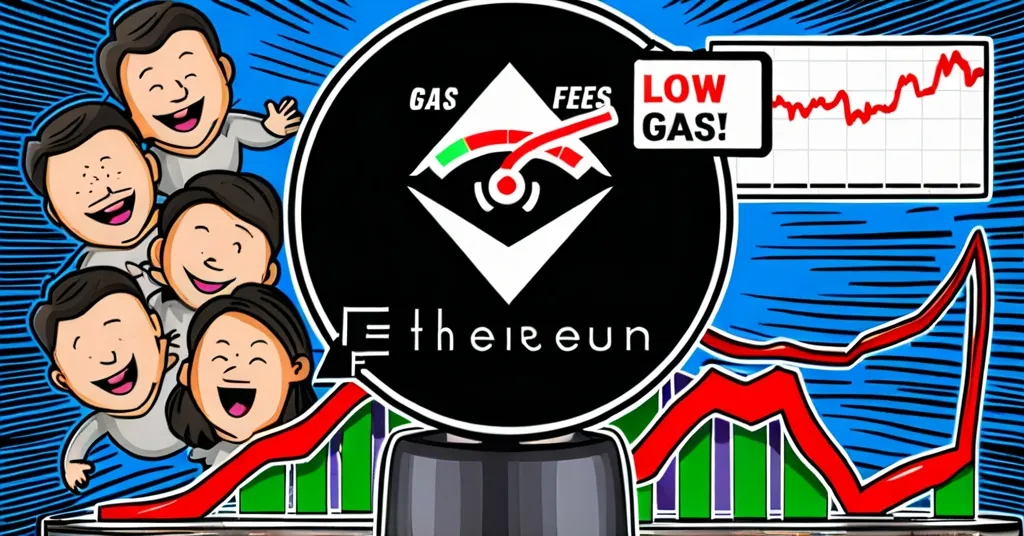Ethereum Gas Fees Hit $0.40 Lowest Since 2020: Network Upgrades Boost Efficiency

Average Ethereum Gas Fees Plummet to $0.40, Marking Lowest Since July 2020
Guess what? Ethereum’s gas fees just hit a low we haven’t seen since July 2020, now hovering at around $0.40. This drop is thanks to some slick network upgrades, like bumping up the block gas limits and rolling out blob transactions. But here’s the kicker: while the network’s getting more efficient, ETH’s price has taken a hit, down 15% in the past month to about $2,800. Let’s unpack what this all means for Ethereum’s future and its community.
- Ethereum transaction fee at $0.40, lowest since July 2020
- Increased block gas limits and blob transactions introduced
- ETH price down 15% in the past month, trading at $2,800
- Low fees signal less network congestion, viewed positively for mid-term and long-term price outlook
- Potential for increased user adoption due to lower costs
What’s Driving the Drop in Gas Fees?
If you’ve ever tried to use Ethereum, you know how frustrating high gas fees can be. But now, things are changing, and it’s all thanks to some clever tech upgrades. The block gas limit, which is like the maximum amount of work a block can do, has been increased. This means more transactions can be processed per block, reducing congestion and, in turn, fees. And then there’s the introduction of blob transactions, which allow data to be handled outside the main network, keeping things running smoothly and cheaply. It’s like moving from a luxury car to a bus ticket in terms of cost.
Impact on Ethereum Users
With gas fees now averaging at $0.40, a simple token swap on Uniswap costs about $0.70, and a basic USDT transfer is just $0.11. These lower fees are a game-changer for users who’ve been dealing with high costs. Imagine being able to send your crypto for the price of a coffee instead of a gourmet meal. This makes Ethereum more accessible and could encourage more people to dive into DeFi platforms, NFT marketplaces, and other decentralized applications. But let’s not forget, while this is great news for users, it might signal a bearish short-term outlook for the network.
As Santiment, a market intelligence platform, puts it:
“When Ethereum transaction fees are low, it usually means the network is not overly crowded. When users are not paying high prices to move their ETH or tokens, it is typically a good sign for mid-term and long-term price outlooks.”
This sentiment suggests that while low transaction fees might signal a bearish short-term outlook, they could pave the way for a more robust future.
The Future of Ethereum
Ethereum’s journey is all about balancing technological progress with market fluctuations. The network’s transition from proof-of-work to proof-of-stake via The Merge, and subsequent upgrades like blob transactions and increased gas limits, are all part of a grand plan to boost Ethereum’s efficiency. But as we’ve seen, these improvements don’t always translate into immediate price appreciation. The 15% drop in ETH’s price over the past month shows that broader market dynamics can play a bigger role.
Looking ahead, the introduction of blob transactions could further enhance Ethereum’s scalability. Each block can now store up to 128 KB of data, with up to 6 blobs per block, significantly reducing data storage costs. This could lead to more complex smart contracts being developed with lower gas costs, benefiting developers, users, and validators alike. However, implementing these changes comes with its own set of challenges, from ensuring secure, decentralized storage to creating a fair fee structure.
Despite these technical strides, Ethereum faces competition from other blockchains and the ongoing complexities of scaling. But with the potential Dencun upgrade on the horizon, which could accommodate up to 64 blobs per block, the future looks promising. Lower fees could attract more newcomers, making Ethereum a more attractive platform for those looking to explore the world of decentralized applications and smart contracts.
Key Questions and Takeaways
- What caused the drop in Ethereum gas fees?
The drop is due to recent Ethereum developments, such as increased block gas limits and blob transactions, which improve network efficiency and reduce congestion.
- How do low Ethereum gas fees impact the network and its users?
Low fees mean less network congestion, making transactions more affordable and accessible. This is positive for users and seen as a good sign for the mid-term and long-term price outlook, though bearish in the short term.
- What are the potential implications of low gas fees for new users?
Lower fees could attract new users, making Ethereum more accessible and cost-effective for them to engage with decentralized applications and smart contracts.
- Is the decline in ETH’s price related to the drop in gas fees?
While both events have occurred, there’s no direct causal link. The price drop may be influenced by broader market dynamics.
- What are blob transactions, and how do they affect Ethereum’s performance?
Blob transactions improve Ethereum’s scalability by handling data off the main chain, reducing congestion and lowering transaction fees.
In this evolving narrative, Ethereum balances technological progress with market fluctuations. As the network refines its infrastructure, the potential for increased user adoption looms large. Ethereum’s journey is a reminder that in the world of crypto, innovation comes with both triumphs and trials.



